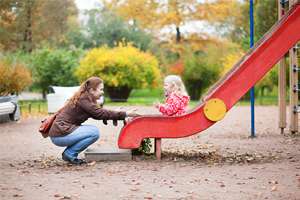Kids get more exercise in smart growth neighborhoods

Children who live in "smart growth" neighborhoods—developments that are designed to increase walkability and have more parks and green space areas—get 46 percent more moderate or vigorous physical activity than kids who live in conventional neighborhoods, finds a study in the American Journal of Preventive Medicine.
"We were surprised by the size of the effect," said Michael Jerrett, Ph.D., professor in the School of Public Health at the University of California, Berkeley and lead author on the study.
He and his colleagues evaluated activity patterns in children aged 8 to 14 who recently moved to a smart growth community called The Preserve near Chino, CA. The researchers compared them with children living in eight nearby conventional communities, matched for ethnicity and family income.
The children wore small accelerometers and global positioning system (GPS) devices to measure their activity levels and determine how much activity occurred outside the home but within the neighborhood. The devices collected and recorded information about their physical activity for seven days and determined that living in a smart growth community would add 10 minutes of activity for each child each day.
"Ten minutes of extra activity a day may not sound like much, but it adds up," said Jerrett. Taking in as little as 15 calories more than you expend on a daily basis can lead to weight gain over time, he noted. A child who weighs 100 pounds might burn an extra 30 calories in those 10 extra minutes of physical activity each day. "The basic idea is that even small things count," he said.
Previous research has found that only 42 percent of children aged 6 to11 get the recommended amount of physical activity. This drops to 8 percent for those aged 12 to 19 years, Jerrett said. In fact, younger children in the smart growth community were 62 percent more active in their neighborhood than older children. Boys were 42 percent more active in the smart neighborhood than girls, Jerrett said.
The conclusions of the study are very consistent with current thinking and research, commented Kaid Benfield, director of sustainable communities at the Natural Resources Defense Council in Washington, D.C. Smart communities are being planned and created, but existing communities can be retrofitted to be smarter and encourage more exercise, he reported.
"The best way to retrofit suburbs is to redevelop parcels of land that become available as strip malls, big-box shopping, and regional malls go out of service – replacing them with more walkable, mixed-use development."
More information: Jerrett, M. et al.(2013) Smart growth community design and physical activity in children, Am J Prev Med.















